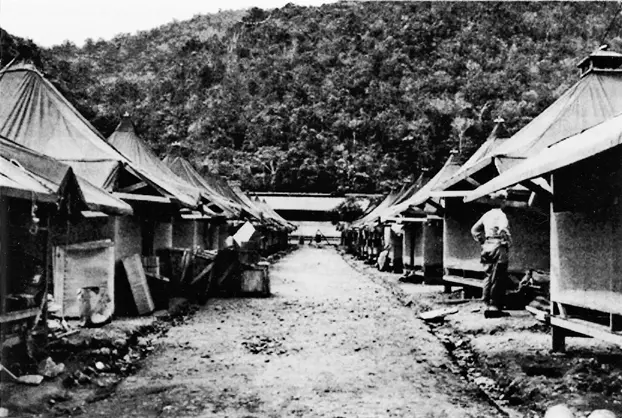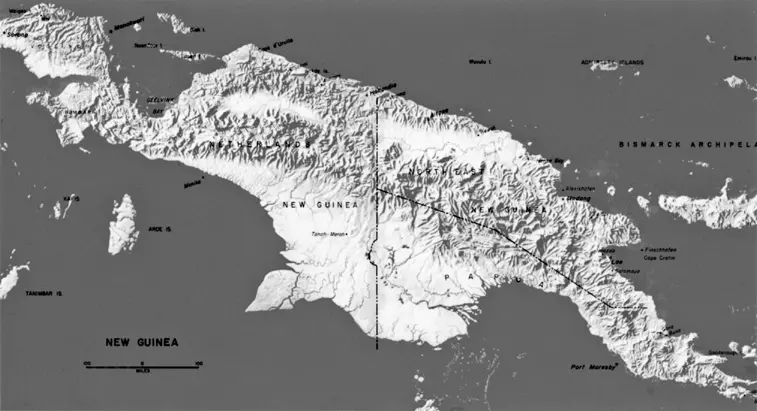When Patrick Hastings telephoned his younger daughters, he did not hold out false hope about their sister’s fate. Outdoing even the Army for brevity, he reduced the telegram to three words: Margaret is missing.
Chapter Two Hollandia
ELEVEN DAYS BEFORE THE MESSENGER APPEARED AT her father’s door, Margaret Hastings awoke as usual before dawn. Already the moist, tropical heat had crept under the flaps of the cramped tent she shared with five other WACs. She dressed alongside her tent mates in the Army-issued khakis she had cut down to match her petite frame. At first, Margaret wrote to a friend back in Owego, the uniforms ‘fit me like sacks’. But after a few failed alteration efforts, she boasted in the letter: ‘I got hold of a pair of men’s trousers that were miles too big for me, and used the material. They really turned out quite well, considering.’
The date was 13 May 1945. It was Sunday, so the bugler had the day off from his usual five-thirty a.m. reveille. Not that Margaret could sleep in. The working week was seven days long at Base G, a sprawling military installation built around the town of Hollandia, on Dutch New Guinea’s northern coast. By eight o’clock, Margaret was due at her post, a metal desk with a clackety typewriter where daily she proved that war wasn’t just hell, it was hell with paperwork.

Tents for members of the Women’s Army Corps in Hollandia, Dutch New Guinea, during the Second World War.
Margaret was thirty years old, lithe and beautiful. She had alert blue eyes, alabaster skin, and long, light-brown hair she wore in a stylish, figure-eight bun. At just 1.56 metres and barely 45 kilos, she could still slip in to her high school wardrobe. Her teenage nickname, ‘Little girl’ remained an apt description. But Margaret’s size was deceptive. She carried herself with style; shoulders back and chin up, the lasting effects of drama club performances, violin lessons, and what her youngest sister called a feisty, ‘take-charge’ nature. She met strangers with a side-long glance and a half smile that dug dimples beneath her high cheekbones. Somewhere between sly and sexy, the look suggested that Margaret had a secret that she had no intention of sharing.
As a girl growing up in Owego, Margaret bicycled to the local swimming hole, hitchhiked when she wanted to explore beyond the village, did well in school, and read books under the covers late at night. As she grew older and prettier, she became one of the most sought-after girls in town. She enjoyed the attention but didn’t depend on it. Margaret considered herself an independent young woman who, as she put it, ‘drank liquor, but not too much’ and ‘liked the boys, but not too much’.
Even after her younger sisters married, Margaret held out beyond the limit of her twenties. She wasn’t interested in the men of Owego, but she didn’t blame them, either. ‘To tell the truth,’ she told an acquaintance, ‘I’m not sure I go for the kind of man who’s supposed to make a good husband.’
After graduating from high school and bouncing through several jobs, Margaret found work as a secretary at a local factory owned by Remington Rand, a company that turned steel into everything from typewriters to .45 calibre pistols. She liked the work, but it bothered her that she had never been farther from home or anywhere more exciting than Atlantic City. It sounded corny, but Margaret wanted to see the world, serve her country, and find out what she was made of. Joining the Women’s Army Corps gave her the chance to do all three.
____
As Margaret got ready for work, families across the United States were preparing for Mother’s Day. This time, though, a mother’s love wasn’t the only cause for celebration. Five days earlier, Germany had surrendered unconditionally. Reports were trickling out that Adolf Hitler had killed himself in his bunker. Other Nazi leaders were in custody. Concentration camps were being liberated, their horrors fully exposed. After a terrible toll of ‘blood, toil, tears and sweat’, victory had finally arrived in Europe. In fact, 13 May 1945 marked five years to the day since Winston Churchill had uttered that phrase to the British people to rouse them for the fight ahead.
To mark the success of the war in Europe, the dome of the US Capitol building, which had been blacked out since Pearl Harbor, again gleamed under the glow of floodlights. As President Truman put it: ‘The western world has been freed of the evil forces which for five years and longer have imprisoned the bodies and broken the lives of millions upon millions of free-born men.’ House Speaker Sam Rayburn hailed the news in Europe but added two sombre notes. He lamented the passing of President Roosevelt weeks before V-E Day. Then he noted that the war wasn’t over: ‘I am happy but also sad, because I cannot help but think of those thousands of our boys who are yet to die in the far-flung Pacific islands and the Far East in order that victory may come to our armies, and that the glory of America may be upheld and peace and an ordered world may come to us again.’
News from the Pacific was encouraging, though fierce engagements continued there. For the previous six weeks, ferocious fighting had been under way on the island of Okinawa, which American generals intended to use as a springboard for an invasion of Japan. Few relished that idea, yet optimism ran high. That morning, the New York Times declared that final victory was assured, whether by negotiated surrender or outright defeat. The paper told its readers, ‘It will be a busy summer for the Japanese enemy, and Hirohito can be confident that the “softening-up” period, now started, will be followed by lethal blows.’
That confident inevitability might have been plain to editors of the Times and to policy makers in Washington. But the war in the Pacific remained a moment-by-moment struggle. Between sunrise and sunset on 13 May 1945, more than 130 US fighters and bombers would attack troops, trains, bridges, and other Japanese ‘targets of opportunity’ in south and east China. Ten B-24 Liberators would bomb an underground hangar on a dot of land called Moen Island. Nine other B-24s would bomb an airfield on a lonely speck in the northern Pacific called Marcus Island. On Borneo, B-24s would bomb two airfields. To the east, B-25 Mitchell bombers and P-38 Lightning fighters would support ground forces on Tarakan Island. The US 7th Marine Division would burst through Japanese defences on Okinawa to capture Dakeshi Ridge. In the Philippines, the 40th Infantry Division would capture Del Monte airfield, and bombers and fighters would pound targets on Luzon Island.
Those were the major events of the day, to be catalogued, analysed and recounted in countless books and films about The Big War. Another incident on 13 May 1945 would escape the notice of historians and filmmakers: a C-47 transport plane carrying two dozen officers, soldiers and WACs would disappear during a flight over the mountainous jungles of New Guinea.

US military map of New Guinea during the Second World War, with Hollandia on the northern coast at roughly the midpoint of the island. The mapmaker was unaware of a large valley some 240 kilometres southwest of Hollandia, in the mountain range that crosses the island’s midsection.
Located between Australia and the Equator, New Guinea was a largely uncharted tropical island 2500 kilometres long and nearly 800 kilometres wide at its centre. The world’s second-largest island, after Greenland, it was a gift-box assortment of inhospitable environments. Much of the coastline featured barely habitable lowlands, swamps, and jungles. In the great middle were soaring limestone mountains covered by impenetrable rainforests and topped by snow or rocky outcroppings. The New Guinea terrain was so forbidding that the most common experience for its inhabitants was isolation. Pockets of humanity carved out small places to survive, fighting with anyone who came near and often among themselves. As a result, the island evolved into a latter-day Babel. New Guinea’s natives spoke more than one thousand languages, or about one-sixth of the world’s total – despite accounting for less than one-tenth of one per cent of the global population.
Читать дальше














